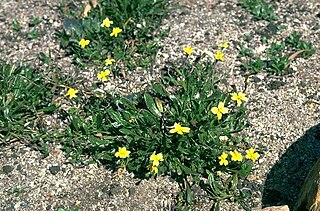Prodromus Florae Novae Hollandiae et Insulae Van Diemen is book dealing with the flora of Australia written by botanist Robert Brown and published in 1810. Often referred to as Prodromus Flora Novae Hollandiae, or by its standard botanical abbreviation Prodr. Fl. Nov. Holland., it was the first attempt at a survey of the Australian flora. It described over 2040 species, over half of which were published for the first time.

Pterostylis grandiflora, commonly known as the cobra greenhood or superb greenhood, is a species of orchid endemic to south-eastern Australia. As with similar orchids, the flowering plants differ from those which are not flowering. The non-flowering plants have a rosette of leaves but the flowering plants lack a rosette and have a single flower with leaves on the flowering spike. This greenhood has a green and white, striped flower with deep red-brown markings especially on its "galea", and a sharply pointed dorsal sepal.

Leichhardtia suaveolens, synonym Marsdenia suaveolens, commonly known as the scented milk vine, is a small vine found in New South Wales, Australia. It is found in a variety of habitats in relatively high rainfall areas, from Bega to Port Macquarie. The original specimen was collected at Sydney on 11 May 1802.

Richea gunnii, the bog candleheath or Gunns richea, is an endemic Tasmanian angiosperm. It is a dicot of the family Ericaceae and is found in Central, Western and North-east Tasmania.

Epacris serpyllifoliais a species of flowering plant in the heath family Ericaceae and is endemic to Tasmania. It is a small low-lying or weakly erect shrub with heart-shaped to broadly egg-shaped leaves and tube-shaped white flowers crowded in upper leaf axils.

Pimelea sericea is a species of flowering plant in the family Thymelaeaceae and is endemic to Tasmania. It is a shrub with densely hairy young stems, elliptic leaves arranged in opposite pairs, and compact clusters of white, pink or pinkish-white flowers.

Pterostylis parviflora, commonly known as the tiny greenhood, is a species of orchid endemic to south-eastern Australia. As with similar orchids, the flowering plants differ from those which are not flowering. The non-flowering plants have a rosette of leaves but the flowering plants lack a rosette at the base but have up to eight tiny green, white and brown flowers.

Pterostylis pedunculata, commonly known as the upright maroonhood, is a species of orchid endemic to south-eastern Australia. Flowering plants have a rosette of two to six stalked leaves and a single green flower which is white near its base and tinged with reddish brown to black and with a gap between the petals and lateral sepals. It is common and widespread in a range of habitats.

Plantago triantha is an annual plant of the family Plantaginaceae that is found in both Tasmania and the Auckland Islands.
Leptocarpus laxus is a rush species of the genus Leptocarpus in the family Restionaceae. It is endemic to the south-west of Western Australia.

Goodenia geniculata, commonly known as bent goodenia or native primrose, is a species of flowering plant in the family Goodeniaceae and is endemic to south-eastern Australia. It is a low-lying to ascending herb with linear to lance-shaped, often toothed leaves at the base of the plant and racemes of yellow flowers with hairy backs.

Westringia angustifolia, commonly known as scabrous westringia, is a flowering plant in the family Lamiaceae and is endemic to Tasmania. It is a small, upright shrub with mauve or white flowers.

Lobelia browniana is a species of flowering plant in the family Campanulaceae and is endemic to eastern Australia. It is an erect, glabrous, annual plant with narrow leaves and one-sided racemes of blue flowers with long, soft hairs in the centre.

Styphelia acuminata is a species of flowering plant in the heath family Ericaceae and is endemic to the Northern Territory. It is a compact, erect shrub with narrowly elliptic or lance-shaped leaves and small groups of white or cream-coloured flowers.
Epacris exserta , commonly known as South Esk heath, is a species of flowering plant in the heath family, Ericaceae and is endemic to Tasmania. It is an erect shrub with narrowly lance-shaped to elliptic leaves and tube-shaped, white flowers clustered near the ends of the branches.

Styphelia biflora is a species of flowering plant in the heath family Ericaceae and is endemic to eastern Australia. It is an erect to spreading shrub with hairy branchlets, oblong leaves and small white flowers.

Styphelia cuspidata is a species of flowering plant in the family Ericaceae and is endemic to the central Queensland coast. It is a shrub with densely hairy young branchlets, egg-shaped to lance-shaped leaves with the narrower end towards the base, and white, bell-shaped flowers that are bearded inside.

Styphelia deformis is a species of flowering plant in the heath family Ericaceae and is endemic to eastern coastal Australia. It is a bushy shrub with narrowly egg-shaped leaves, and white, tube-shaped flowers.
Pimelea cinerea is a species of flowering plant in the family Thymelaeaceae and is endemic to Tasmania. It is a slender shrub with more or less elliptic leaves, and heads of white flowers surrounded by leaves.
Styphelia compacta is a species of flowering plant in the heath family Ericaceae and is endemic to the south-west of Western Australia. It is a widely spreading or prostrate, much-branched shrub with egg-shaped leaves or lance-shaped leaves with the narrower end towards the base, and red flowers arranged in leaf axils.

















